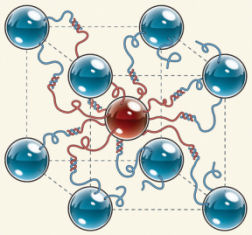- More than 2 years ago
Using DNA as a sort of Velcro, two separate teams of scientists have created what may be the first nanomaterials that assemble themselves into ordered 3-D structures. The techniques may enable the creation of crystals with novel properties.

Using the propensity of DNA’s chemical bases to bind to their ideal complements—A with T, C with G—researchers had previously put DNA to work to self-assemble into orderly 2-D arrangements or chaotic 3-D lumps.
To create the first true 3-D materials from nanoscale components, each team attached single strands of DNA to gold spheres about 10 nanometers across. The scientists used two different DNA sequences to create two distinct batches of nanospheres. The DNA sequences were chosen so that, when the two batches were mixed, the unattached ends from one batch would latch only on to the ends in the other batch.
After repeated cycles of heating and cooling, the nanospheres found their most stable configurations, interlocking into a 3-D lattice of spheres linked by DNA and resembling a web of mattress springs. Its arrangement mirrored that of atoms in a crystal—but on scales 50 or 60 times as large. The results appear in two papers in the Jan. 31 Nature and one in the Feb. 27 Journal of the American Chemical Society.
“This is really a new form of matter,” says Chad Mirkin of Northwestern University in Evanston, Ill., who led one of the teams. The structures also leave plenty of space between spheres, points out Oleg Gang of Brookhaven National Laboratory in Upton, N.Y., who led the other team. This space leaves room for custom designing crystals with new magnetic or catalytic properties—and maybe unusual lenses such as those envisioned for invisibility cloaks.





